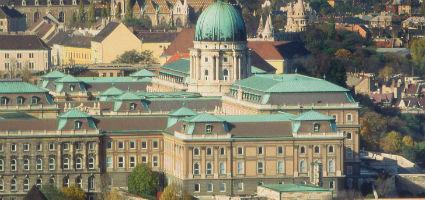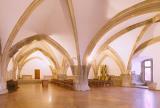2025. July 2. Wednesday
Budapest History Museum - Budapest
 |
Address: 1014, Budapest Szent György tér 2.
Phone number: (1) 487-8800, (1) 487-8801
E-mail: btm@mail.btm.hu
Opening hours: Tue-Sun 10-18
|
Thanks to her growing sense of nationhood and her developing middle class, during the course of the nineteenth century Hungary saw the creation of several museums. First among these new institutions was the National Museum. A museum dedicated solely to the history of Budapest came into existence only toward the end of the last century. Its core collection consisted of finds from the building sites, from archaeological excavations, and earlier collections which help shed light on of Budapest's history. Long before the establishment of the Museum a number of art-loving members of the municipal council had recognized the importance of preserving the city's heritage.
In 1887 the municipal authorities of Budapest decided to create a new museum dedicated to the history of the capital. In 1967, after several changes of location, the central branch of the museum found a permanent home in the newly renovated Royal Palace in Buda.
The chief task of the museum is the research and organization of the capital's and, especially, of Buda Castle's historic finds. The curators working at the Károlyi Palace are in charge of excavation and post-excavation work of prehistoric times and the Migration Period. Roman antiquities fall within the domain of the Aquincum Museum, while the Kiscell Museum collects artifacts relating to the capital's more recent history. It also collects and constantly enlarges the museum's fine arts collection.
The oldest finds of the Museum date back more than forty thousand years. The deer antler hammers, for instance, served prehistoric man as tools to extract flint nodules from the hillside at Farkasrét. A neolithic vessel bears an image of the goddess of fertility, while a bell-shaped beaker form the Bronze Age is remarkable for its sophisticated shape and abundant ornamentation. The small clay pots and other clay objects, probably intended for ritual use, are among the rich Bronze Age finds. There is an urn, turned on the wheel, which belongs to the Celtic Iron Age, while the Eraviscan vessel shows signs of Roman stylistic influence.
Finds reflecting a more advanced civilization indicate influences exerted during the period of the Roman Conquest. Among these are implements, surveying tools, and a portable organ, as well frescoes and mosaic pavements embellished with vivid scenes from everyday life, exotic animals, figures made of bronze or stone, inscribed funerary monuments, finely wrought glass ware, decorated pots, and pieces of gold jewellery.
After the withdrawal of the Roman legions from Pannonia, Germanic tribes settles in their place. Long inter-tribal warfare followed, which was eventually stopped by the invasion of the Carpathian Basin by the Asiatic Huns who, in their turn, were replaced by the Avars, newcomers from the East. Among the artifacts of the great Migration Period we find exquisite fibulae, gilded and silvered bronze-decorated leather belts, silver gilt diches, gold ear-rings and coloured glass beads. Of the few finds from the time of the Magyar Coquest, the Museum owns beautifully ornamented belt buckles found in the area of today's Budapest.
During the Middle Ages Buda became the centre of royal power. The presence of royalty prompted a great deal of building activity, chief among which was the construction of Buda's royal castle. Under subsequent kings Buda Castle was greatly enlarged and refurbished according to the requirements of contemporary fashion. Objects of every-day life such as dishes and cooking utensils, stove tiles and coins, which shed light on the artistic achievements of the period, were uncorvered during excavations. Among these were also fragments of splendid Gothic carvings ad finds from the age of King Matthias and the period of Turkish occupation.
The Museum deals with the material remains of the period between the liberation of Buda from the Turks and the beginning of the twentieth century. Here we find objects relating to the guilds, masterly creations of clock- and furniture-makers, finely worked silver and gold ornaments, vessels made of porcelain, glass and silver, dresses, knicknacks, maps, architectural drawings for the embellishment of Pest, colourful posters from the early part of the twentieth century along with photographs revealing the darker aspects of modern life.
In its picture gallery the Museum displays a superb collection of old prints depicting Pest, Buda and Óbuda, examples of decorative art rescued from old buildings, as well as paintings, sculpture and drawings of all periods.
In 1896 the collection of the Aquincum Museum consisted of 3.734 items. In 1899, with the addition of objects in the City Park Museum, the total number of artifacts and historical documents reached 8.566. By 1935 the number of objects in the different collections grew to 47.572 and in 1978 to a round 350.000. By 1995 their quantity increased to 400.000 which figure does not include the several hundred thousand finds still waiting to be classified.
The number of visitors to Aquincum in 1897 was 12.000 in 1907, including visitors to the City Park premises, their numbers grew to 34.545 in 1936 to 53.504, and in 1995 the total number of visitors to the various branches of the Budapest History Museum reached 210.000.
The role of a museum must be to share its treasures with the public, to promote public interest, and to serve society at large. To fulfil its civic obligations, the Budapest History Museum is becoming more and more "user friendly". We know that to create a viable and important institution the visiting public must feel a need to partake of what the Museum has to offer and to appreciate what it represents in cultural terms. This is the only was this institution can ensure its long term survival. The cultural heritage of our country and of our city, which is in the safe-keeping of our Museum, belongs to all - to students and old age pensioners, to historians, art lovers and tourists, to Hungarians and foreigns alike.
In 1887 the municipal authorities of Budapest decided to create a new museum dedicated to the history of the capital. In 1967, after several changes of location, the central branch of the museum found a permanent home in the newly renovated Royal Palace in Buda.
The chief task of the museum is the research and organization of the capital's and, especially, of Buda Castle's historic finds. The curators working at the Károlyi Palace are in charge of excavation and post-excavation work of prehistoric times and the Migration Period. Roman antiquities fall within the domain of the Aquincum Museum, while the Kiscell Museum collects artifacts relating to the capital's more recent history. It also collects and constantly enlarges the museum's fine arts collection.
The oldest finds of the Museum date back more than forty thousand years. The deer antler hammers, for instance, served prehistoric man as tools to extract flint nodules from the hillside at Farkasrét. A neolithic vessel bears an image of the goddess of fertility, while a bell-shaped beaker form the Bronze Age is remarkable for its sophisticated shape and abundant ornamentation. The small clay pots and other clay objects, probably intended for ritual use, are among the rich Bronze Age finds. There is an urn, turned on the wheel, which belongs to the Celtic Iron Age, while the Eraviscan vessel shows signs of Roman stylistic influence.
Finds reflecting a more advanced civilization indicate influences exerted during the period of the Roman Conquest. Among these are implements, surveying tools, and a portable organ, as well frescoes and mosaic pavements embellished with vivid scenes from everyday life, exotic animals, figures made of bronze or stone, inscribed funerary monuments, finely wrought glass ware, decorated pots, and pieces of gold jewellery.
After the withdrawal of the Roman legions from Pannonia, Germanic tribes settles in their place. Long inter-tribal warfare followed, which was eventually stopped by the invasion of the Carpathian Basin by the Asiatic Huns who, in their turn, were replaced by the Avars, newcomers from the East. Among the artifacts of the great Migration Period we find exquisite fibulae, gilded and silvered bronze-decorated leather belts, silver gilt diches, gold ear-rings and coloured glass beads. Of the few finds from the time of the Magyar Coquest, the Museum owns beautifully ornamented belt buckles found in the area of today's Budapest.
During the Middle Ages Buda became the centre of royal power. The presence of royalty prompted a great deal of building activity, chief among which was the construction of Buda's royal castle. Under subsequent kings Buda Castle was greatly enlarged and refurbished according to the requirements of contemporary fashion. Objects of every-day life such as dishes and cooking utensils, stove tiles and coins, which shed light on the artistic achievements of the period, were uncorvered during excavations. Among these were also fragments of splendid Gothic carvings ad finds from the age of King Matthias and the period of Turkish occupation.
The Museum deals with the material remains of the period between the liberation of Buda from the Turks and the beginning of the twentieth century. Here we find objects relating to the guilds, masterly creations of clock- and furniture-makers, finely worked silver and gold ornaments, vessels made of porcelain, glass and silver, dresses, knicknacks, maps, architectural drawings for the embellishment of Pest, colourful posters from the early part of the twentieth century along with photographs revealing the darker aspects of modern life.
In its picture gallery the Museum displays a superb collection of old prints depicting Pest, Buda and Óbuda, examples of decorative art rescued from old buildings, as well as paintings, sculpture and drawings of all periods.
In 1896 the collection of the Aquincum Museum consisted of 3.734 items. In 1899, with the addition of objects in the City Park Museum, the total number of artifacts and historical documents reached 8.566. By 1935 the number of objects in the different collections grew to 47.572 and in 1978 to a round 350.000. By 1995 their quantity increased to 400.000 which figure does not include the several hundred thousand finds still waiting to be classified.
The number of visitors to Aquincum in 1897 was 12.000 in 1907, including visitors to the City Park premises, their numbers grew to 34.545 in 1936 to 53.504, and in 1995 the total number of visitors to the various branches of the Budapest History Museum reached 210.000.
The role of a museum must be to share its treasures with the public, to promote public interest, and to serve society at large. To fulfil its civic obligations, the Budapest History Museum is becoming more and more "user friendly". We know that to create a viable and important institution the visiting public must feel a need to partake of what the Museum has to offer and to appreciate what it represents in cultural terms. This is the only was this institution can ensure its long term survival. The cultural heritage of our country and of our city, which is in the safe-keeping of our Museum, belongs to all - to students and old age pensioners, to historians, art lovers and tourists, to Hungarians and foreigns alike.
